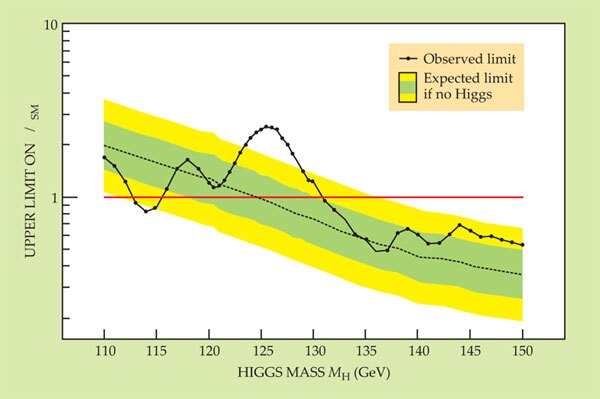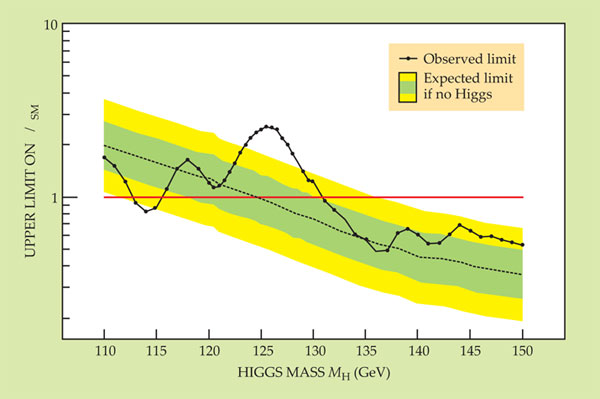The Large Hadron Collider yields tantalizing hints of the Higgs boson
DOI: 10.1063/PT.3.1425
On 13 December, a standing-room-only audience at CERN and webcast viewers worldwide heard representatives of the two principal detector teams at the laboratory’s Large Hadron Collider (LHC) report the year-end status of their searches for the Higgs boson. Interest in a possible first sighting of this last undiscovered particle required by particle theory’s standard model (SM) is unusually widespread.
In the SM, the quantum field of the Higgs boson serves to break the underlying symmetry of the model’s unification of the electromagnetic and weak interactions. It bestows the requisite large masses on the W± and Z0 bosons that mediate the short-range weak interactions, while leaving their sibling, the photon, massless and free ranging. Coupling to the Higgs field also accounts for the nonvanishing masses of the fundamental fermions: the quarks and leptons.
The SM Higgs boson H has neither charge nor spin. (One speaks of an SM Higgs to distinguish it from the many elaborations beyond the SM that theorists have in their pockets, just in case.) The SM does not specify the Higgs mass MH, but it does predict the particle’s production cross section and decay rates as functions of MH. Precision measurements of electroweak parameters and null results of searches at other colliders had pretty much restricted MH to the range 114–156 GeV. (For comparison, the proton weighs about 1 GeV.) So that has been the mass region to which the teams running the gargantuan ATLAS and CMS detectors at the LHC have given particular attention in their searches, which began early in 2010.
By April 2011, the LHC was running well enough with colliding beams of 3.5-TeV protons for CERN director-general Rolf Heuer to predict a statistically robust determination of the existence, or nonexistence, of an SM Higgs by the end of 2012. But since April, the collider’s performance has far surpassed expectations—providing each detector a total of 5 × 1014 proton–proton collisions by the end of October. That unanticipated abundance, though still not enough for a conclusive Higgs discovery, has yielded the tantalizing hints that were the highlights of the 13 December colloquium.
ATLAS and CMS spokespersons Fabiola Gianotti and Guido Tonelli, reporting their data on the expected Higgs decay modes, 1,2 showed “intriguing” mass peaks consistent with MH near 125 GeV. But the peaks were also consistent with statistical fluctuations of 2.3 standard deviations for ATLAS and 1.9 standard deviations for CMS. Those quoted statistical significances do not, however, take into account the encouraging fact that both teams saw very similar results. “But even taken together, they can’t be regarded as a discovery,” cautioned Gianotti. “That,” added Tonelli, “will require the LHC’s 2012 run.”
Looking for Higgs decays
The SM expectation is that 5 × 1014 pp collisions would produce almost 104 Higgs bosons in each detector. But with a lifetime of only 10−22 seconds, an H could be seen and weighed only through its decay products, identified against an overwhelming background of hadronic collision debris.
In the MH region under principal scrutiny, the only decay modes that would have both adequate detection rates and mass resolution are H → γγ and H → Z0Z0 → 2(ℓ+ℓ−). The detectors are good at distinguishing high-energy gammas (γ) and charged leptons (ℓ±) from the much more abundant hadrons. Still, for the two “golden” modes combined, the excess over the expected non-Higgs background would be only a few dozen events in each detector over the entire LHC run so far.
Indeed both teams found that their observed MH distributions for the γγ and ZZ modes showed peaks above background near 125 GeV. Each peak, with roughly the expected amplitude, is, by itself, statistically marginal. But they all fall within a few GeV of 125 GeV—a spread consistent with the measurement uncertainties.
The case for an SM Higgs sighting was further bolstered by a third decay mode: H → W+W− → ℓ+νℓ−ν. Its mass resolution is degraded by the two invisible neutrinos (ν), but both teams find that the WW data contribute significantly to the broad excess of events they found in the mass region 110–140 GeV. The combined ATLAS data for the three decay modes peak at 126 GeV, and the CMS peak for the combined modes is centered at 124 GeV.
As a function of MH, the ATLAS team’s summary figure on page 17 plots the 95%-confidence upper limit on the Higgs-production cross section σ deduced from the data and normalized to the SM predictions σSM(MH). Those upper limits serve to exclude an SM Higgs heavier than 131 GeV. Similarly, the CMS data exclude MH above 128 GeV.

The ATLAS team’s observed upper limits (at 95% confidence) on the cross section σ for producing a Higgs boson of mass MH, divided by the standard-model prediction σSM, are plotted (solid black curve) against MH. Putative Higgs masses for which the upper limit drops below 1 (red line) are excluded with 95% confidence. The green and yellow swath, two standard deviations wide, indicates the upper cross-section limits the data sample should yield in the absence of a Higgs boson. (Adapted from ref.

The figure’s green and yellow swath shows the SM expectation (two standard deviations wide) for what upper limits the experimenters could extract from the data sample if there were no Higgs in that mass region. One gets an idea of the statistical significance of the peak at 126 GeV by noting how far it rises above the swath. More LHC running will move the swath downward, raising a true Higgs peak farther above what a two-standard-deviation statistical fluke could mimic.
”Though we can’t yet claim a discovery,” says Heuer, “the fantastic performance of the collider and the two detectors over the past year has significantly narrowed the mass range in which a standard-model Higgs might, or might not, be hiding.” Either result would be momentous, if it’s statistically convincing—which it should be by the time the LHC shuts down in November for an 18-month upgrade of the colliding proton beams to their 7-TeV design energies.
References
1. ATLAS collaboration, available at http://cdsweb.cern.ch/record/1406358/files/ATLAS-CONF-2011-163.pdf
2. CMS collaboration, available at http://cdsweb.cern.ch/record/1406347/files/HIG-11-032-pas.pdf
